Are drag queens men who want to be women, who identify as women, who consider themselves transgender?
No.
Yes.
Maybe. But probably not.
~ ~ ~ ~ ~ ~ ~ ~ ~
Drag has been around for a long time, so long that no one is sure from where the name originated. The common thought is that it is an acronym, where D.R.A.G. stands for Dressed Resembling A Girl. Some contend that it comes from men struggling to drag around the full length gowns of women, as in the era of the photo, below.
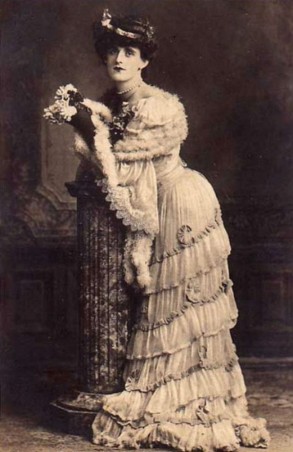
While drag queens are more common, there also are drag kings, women who are Dressed Resembling A Guy. Because drag queens both predominate and, of late, have made a splash into the mainstream, I will concentrate on them.
Surpassing whether or not drag artists are transgender is understanding what drag is. Drag is performance art. It’s entertainment. It’s over-the-top playing the opposite sex for the purpose of putting on a show or simply having fun.
Anyone can do drag and, nowadays, it seems is. Drag shows are everywhere from professionals making a living in nightclubs to college students getting dressed up to raise money for a charity. RuPaul, the now famous drag queen, of whom I first became aware twenty-five years ago, hosts the continually-growing-in-popularity RuPaul’s Drag Race, which has been renewed for a tenth season.

Generally, drag queens are gay men. “Queen,” which now is celebrated and embraced, began as a demeaning slur against homosexual men.
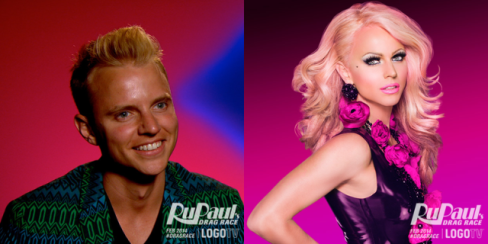
Drag has long been common in gay bars. But not only gay men do drag; it’s not a requirement. Straight guys do it, too, the most famous of whom might be Barry Humphries, married to a woman, who parlayed his character, Dame Edna Everage, into a long career that included a popular television talk show parody, the late 1980s’ The Dame Edna Experience. (I loved the show. I envied Humphries for being able to play a woman in public, and the guy was just plain hilarious.)
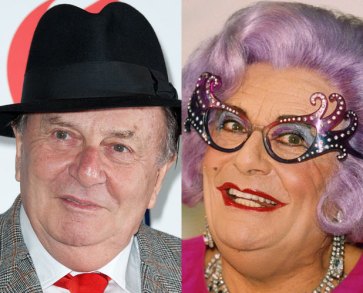
Some males get into drag, who are dealing with gender identity issues. Every year during Rupaul’s Drag Race there will usually be one or two contestants who announce that they are, in fact, transgender.
Carmen Roman—better known by the stage name she took when she began drag, Carmen Carrera—is a trans woman who began work as a gay male doing drag. A couple of years into it, she revealed that she is transgender, and now has fully transitioned. As a male, she had married a man. They remained married through her transition, but eventually divorced.
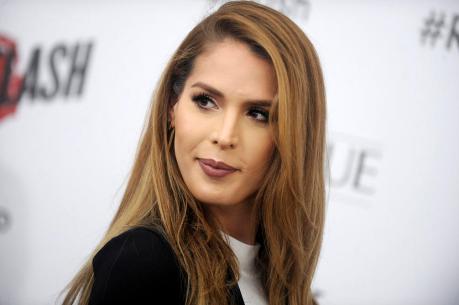
Carmen Carrera is the exception to the drag queen rule. Generally, if you watch Rupaul’s Drag Race, or see drag queens in the news—this summer, there was a report of drag queens reading books to kids in libraries as part of a worthy cause—your first assumption should be that they are regular guys who do drag for whatever their reason might be.
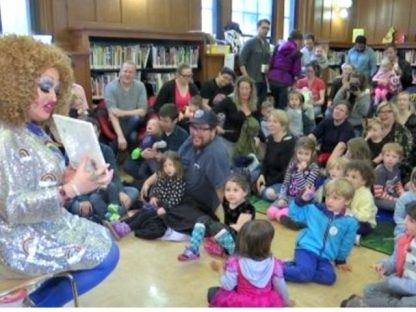
It seems to me that when a person, such as Carmen Roman, began as a drag queen but then comes to identify as transgender, she should no longer be called a drag queen. But this has not been the case with many who are full time trans women and continue to do drag. So, not only can males be drag queens, so can transgender women. Oh, and so can cisgender women, both straight and lesbian, perform as drag queens.
The art is open to all.
Drag is synonymous with over-the-top. The point of drag is not, in the strict sense, to impersonate females, but to have fun with the hair and clothes and makeup.
While the term “female impersonator” is not used as much as it used to be, when men want to convince an audience that they are seeing a woman, the men keep their hair, makeup, and dress in conformity with typical feminine appearance.
Often, the aim of the female impersonator is to mimic a famous woman. The first female impersonator I ever saw was on The Carol Burnett Show, in 1972. The video, above, is from that episode. Jim Bailey appeared as Barbra Streisand, even singing her songs in his own voice. In places like Las Vegas, one can find female impersonator shows. Impersonators of Cher, Madonna, Britney Spears and Dolly Parton remain favorites.
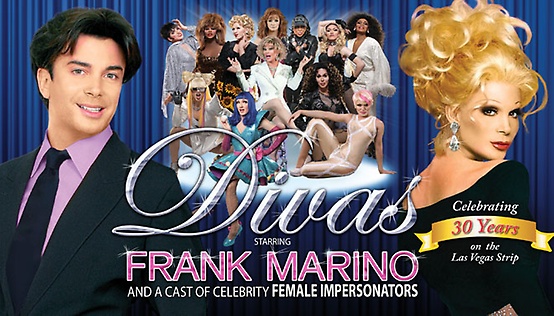
Turning around the discussion, don’t think that trans women want to be drag queens. While I love performing, and probably would have a ball as a queen, I don’t have any interest in it. I might first want to actually go to a drag show, something which I’ve never done.
You don’t have to be transgender, or gay, or lesbian, or bi, or queer to enjoy drag. When it is done well—superb wigs, expert makeup application, splendid clothing, all wrapped into performance which clearly has been well-rehearsed—drag can be as entertaining a show as anything.
And its usually done by guys who like being guys.
~ ~ ~ ~ ~ ~ ~ ~ ~
From the mid-1980s to 1990, I performed four years in the Montague Showboat. One year, I wrote a skit which was set in a diner, with a mouthy waitress as the star. There were a lot of lines to learn and we struggled to find a woman to play the lead role. No one knew, but I really wanted to play this part, both because I would get to play a woman and for the saucy punchlines she would get to deliver. I had to contain my giddiness when I “volunteered” to take on the role.
I’m sorry for the poor quality of these pictures, but that’s me, center stage, when I was in my early 30s.
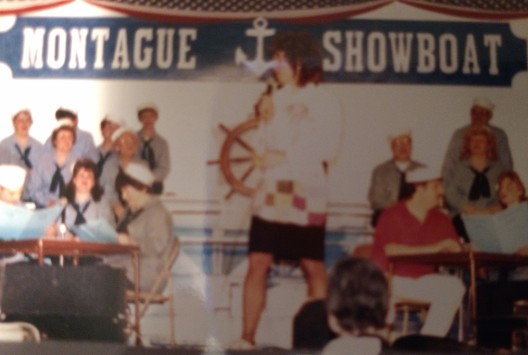
Below, I am waiting on the unsuspecting John Calkins. He asked, “What’s the soup of the day?” I replied, “It’s creamed pheasant.” As he drooled, “Mmm, that sounds good,” I interrupted, “Yup. I creamed that pheasant with my Buick on my way to work this morning!”
Raucous laughter ensued.
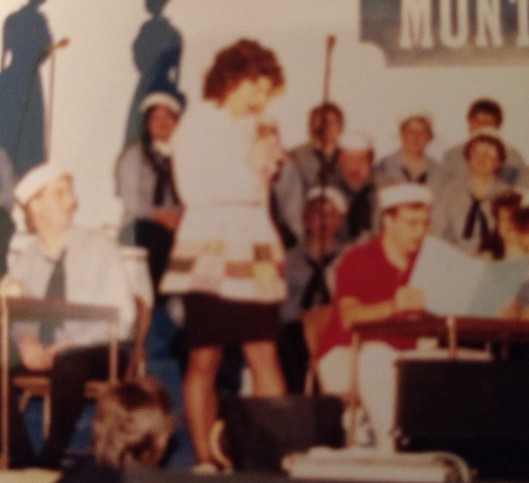
I considered this neither playing a drag queen or being a female impersonator. Besides, I surely wasn’t good enough to receive either lofty designation.
i suppose it would be presumptuous to call it “trans for the weekend.” its gender exploration– even if the territory is familiar. of course its one of those words that can be vague, you could say drag is “what drag queens do.” also k.d. lang, who is clearly in touch with her “masculine” side.
i dont think of k.d. lang is trans, and i certainly cant speak for her– i dont suspect that she thinks of herself as a man. a bit “masculine?” yes. whatever that means, yes. and of course i love her for it– when i was a kid i didnt care. but now… she is just amazing. my favourite drag queen ever was this puerto rican college boy at a party… (no, it wasnt like that.) but he had the best dress of anyone there.
you cant expound on what drag is without being too narrow? probably. my first close trans friend (identifies as male, i always have/do think of him as male, hes a little non-binary and prefers “he” though loves being non-binary-ish) i asked him: “how do you know *when* youre in drag?” (rookie question, i know) he said: “when i say so!” fair enough. the intersection of transgender and high-functioning autism is interesting to say the least. political correctness aside, i think his autism did define him at least as much as his gender. i speak of him more than myself, though we had enough in common.
LikeLike
Good to see you, codeinfig, and so chatty! 🙂
“Trans for the weekend.” Cute. And since when don’t you speak for k d lang? Does she know that you resigned your position?
“When I say so!” Your trans friend has the definitive answer on that!
LikeLike
The pheasant bit is pleasant. Consider the LIKE star checked.
LikeLiked by 1 person
Check on the check!
LikeLike
I love watching rupaul’s Drag Race and now I learned that drag is Dressed Resembling A Girl. hehehehe
LikeLike
You silly wabbit, JR. 🙂
LikeLiked by 1 person
hehehehe
LikeLike